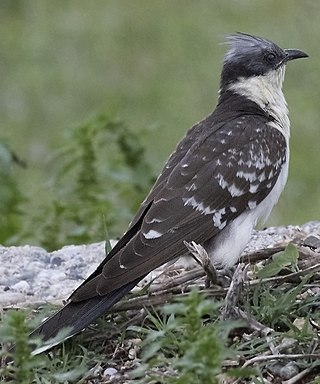
The great spotted cuckoo is a member of the cuckoo order of birds, the Cuculiformes, which also includes the roadrunners, the anis and the coucals.

The Senegal coucal is a member of the cuckoo order of birds, the Cuculiformes, which also includes the roadrunners, the anis, and the hoatzin. It is a medium-sized member of its genus and is found in lightly-wooded country and savannah in central and southern Africa.
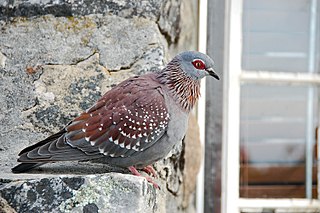
The speckled pigeon, also African rock pigeon or Guinea pigeon, is a pigeon that is a resident breeding bird in much of Africa south of the Sahara. It is a common and widespread species in open habitats over much of its range, although there are sizable gaps in its distribution. It is sometimes referred to as the Guinea pigeon due to its similar coloring to some species of guineafowl.

The emerald dove or common emerald dove, also called Asian emerald dove and grey-capped emerald dove, is a widespread resident breeding pigeon native to the tropical and subtropical parts of the Indian Subcontinent and Southeast Asia. The dove is also known by the names of green dove and green-winged pigeon. The common emerald dove is the state bird of the Indian state of Tamil Nadu. The Pacific emerald dove and Stephan's emerald dove were both considered conspecific.

The ruddy quail-dove is a species of bird in the dove and pigeon family Columbidae. It breeds throughout the West Indies, Central America, and tropical South America. It has appeared as a vagrant in Florida and southern Texas. It lays two buff-colored eggs on a flimsy platform built on a shrub. Some nests are built on the ground.

Cuculus is a genus of cuckoos which has representatives in most of the Old World, although the greatest diversity is in tropical southern and southeastern Asia.
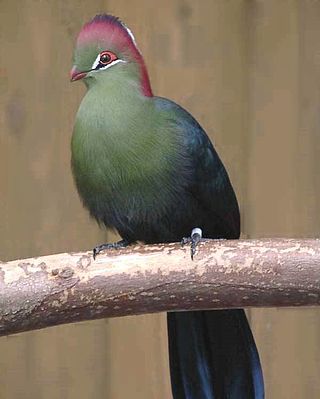
Tauraco is a genus of turacos. It contains the "typical" or green turacos; though their plumage is not always green all over, the presence of significant amounts of turacoverdin-colored plumage generally sets Tauraco species apart from other Musophagidae. Indeed, as opposed to any other known birds, Tauraco turacos are the only living bird taxa that have any significant green pigment whatsoever, as the greens of many parrots etc. are due to structural color, not pigment. Their genus name was derived from a native West African name.
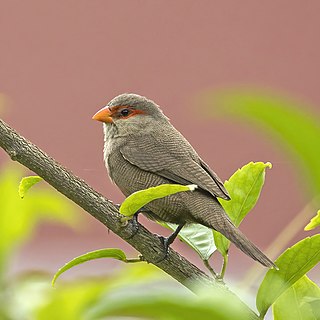
The common waxbill, also known as the St Helena waxbill, is a small passerine bird belonging to the estrildid finch family. It is native to sub-Saharan Africa but has been introduced to many other regions of the world and now has an estimated global extent of occurrence of 10,000,000 km2. It is popular and easy to keep in captivity.

The red-headed lovebird also known as the red-faced lovebird is a member of the genus Agapornis, a group commonly known as lovebirds. Like other lovebirds it is native to Africa.

The green-winged pytilia is a small colourful seed-eating bird in the family Estrildidae. It is widespread throughout Sub-Saharan Africa, though it is more rarely seen in central, far southern and coastal western parts of the continent.
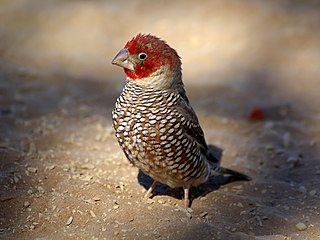
The red-headed finch is a common species of estrildid finch found in Africa. It has an estimated global extent of occurrence of 1,600,000 km2. It is found in Angola, Botswana, Lesotho, Namibia, South Africa and Zimbabwe.
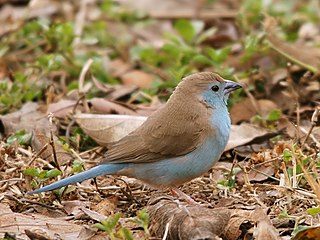
The blue waxbill, also called southern blue waxbill, blue-breasted waxbill, southern cordon-bleu, blue-cheeked cordon-bleu, blue-breasted cordon-bleu and Angola cordon-bleu, is a common species of estrildid finch found in Southern Africa. It is also relatively commonly kept as an aviary bird.
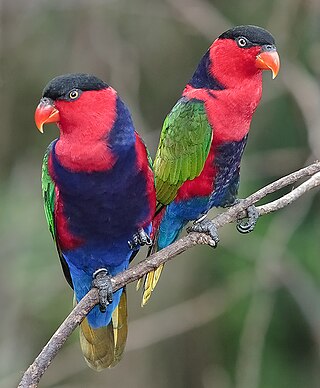
The black-capped lory also known as western black-capped lory or the tricolored lory, is a parrot found in New Guinea and adjacent smaller islands. It is a colourful and relatively robust lory. There are seven subspecies, all with green wings, red heads and body around the wing, a black cap, grey-black cere, yellow underwings, and blue legs and belly. Most also have a blue nape and mantle. It remains overall widespread and common, but the subspecies cyanuchen is relatively rare, with fewer than 5,000 individuals remaining.

The yellow-billed turaco is a species of bird in the family Musophagidae. It is found in Angola, Cameroon, Republic of the Congo, Democratic Republic of the Congo, Ivory Coast, Equatorial Guinea, Gabon, Ghana, Guinea, Liberia, Nigeria, and Sierra Leone.

The Arabian bustard is a species of bustard which is found across the Sahel region of Africa and south western Arabia. It is part of the large-bodied genus, Ardeotis, and, though little known, appears to be a fairly typical species in that group.
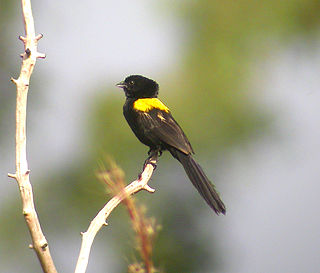
The yellow-mantled widowbird, also known as the yellow-backed widow, is a species of bird in the family Ploceidae.

The scarlet-chested sunbird is a species of bird in the family Nectariniidae.

The southern red bishop or red bishop is a small passerine bird belonging to the bishop and widowbird genus Euplectes in the weaver family, the Ploceidae. It is common in wetlands and grassland in Africa south of the Equator. North of the Equator, it is replaced by the northern red bishop or orange bishop which was formerly regarded as a subspecies of this species.
In the 10th edition of Systema Naturae, published in 1758, the Swedish naturalist Carl Linnaeus described 554 species of bird and gave each a binomial name.
Zenker's turaco, is a subspecies of the Guinea turaco. It is a green turaco, in the family Musophagidae, subfamily Tauracinae, a group of near-passerines birds. Zenker's turaco is found in forests of Central Africa in the Congo Basin in Gabon, DR Congo and Congo-Brazzaville and south to northern Angola. It forms part of a superspecies complex that extends from West Africa to East Africa and as far south as the Cape in Southern Africa and include the black-billed turaco, Emin's turaco, Schalow's turaco, Livingstone's turaco, the Transvaal turaco and the Knysna turaco, as subspecies within the group.





















